科技论文写作英语写作
- 格式:doc
- 大小:28.00 KB
- 文档页数:7

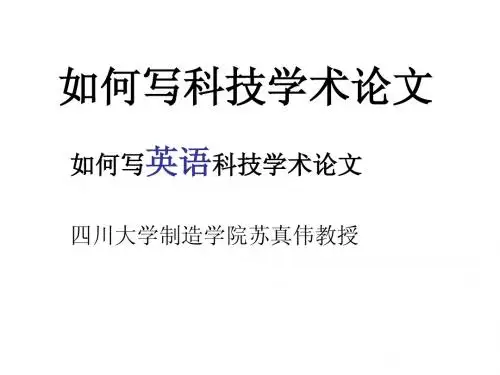
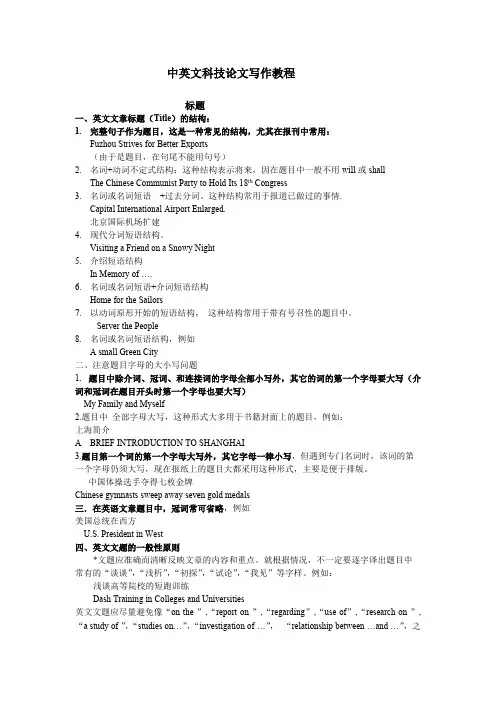
中英文科技论文写作教程标题一、英文文章标题(Title)的结构:1.完整句子作为题目,这是一种常见的结构,尤其在报刊中常用:Fuzhou Strives for Better Exports(由于是题目,在句尾不能用句号)2.名词+动词不定式结构:这种结构表示将来,因在题目中一般不用will或shallThe Chinese Communist Party to Hold Its 18th Congress3.名词或名词短语+过去分词。
这种结构常用于报道已做过的事情.Capital International Airport Enlarged.北京国际机场扩建4.现代分词短语结构。
Visiting a Friend on a Snowy Night5.介绍短语结构In Memory of ….6.名词或名词短语+介词短语结构Home for the Sailors7.以动词原形开始的短语结构,这种结构常用于带有号召性的题目中。
Server the People8.名词或名词短语结构,例如A small Green City二、注意题目字母的大小写问题1. 题目中除介词、冠词、和连接词的字母全部小写外,其它的词的第一个字母要大写(介词和冠词在题目开头时第一个字母也要大写)My Family and Myself2.题目中全部字母大写,这种形式大多用于书籍封面上的题目,例如:上海简介A BRIEF INTRODUCTION TO SHANGHAI3.题目第一个词的第一个字母大写外,其它字母一律小写,但遇到专门名词时,该词的第一个字母仍须大写,现在报纸上的题目大都采用这种形式,主要是便于排版。
中国体操选手夺得七枚金牌Chinese gymnasts sweep away seven gold medals三.在英语文章题目中,冠词常可省略,例如美国总统在西方U.S. President in West四、英文文题的一般性原则*文题应准确而清晰反映文章的内容和重点。
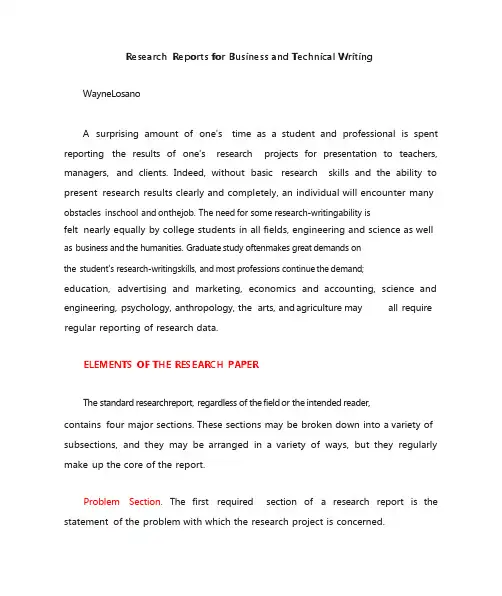
Research Reports for Business and Technical WritingWayneLosanoA surprising amount of one's time as a student and professional is spent reporting the results of one's research projects for presentation to teachers, managers, and clients. Indeed, without basic research skills and the ability to present research results clearly and completely, an individual will encounter many obstacles inschool and onthejob.The need for some research-writingability isfelt nearly equally by college students in all fields, engineering and science as well as business and the humanities.Graduate study oftenmakes great demands onthe student's research-writingskills,and most professions continue the demand;education, advertising and marketing, economics and accounting, science and engineering, psychology, anthropology, the arts, and agriculture may all require regular reporting of research data.ELEMENTS OF THE RESEARCH PAPERThe standard researchreport,regardless of the field or the intended reader,contains four major sections. These sections may be broken down into a variety of subsections, and they may be arranged in a variety of ways, but they regularly make up the core of the report.Problem Section. The first required section of a research report is the statement of the problem with which the research project is concerned.This sectionrequires a precise statement of the underlyingquestionwhichtheresearcher has set out to answer. In this same section there should be anexplanation of the significance - social, economic, medical, psychological, educational,etc.-of the question;inother words,why the investigationwas worth conducting. Thus, if we set out, for example, to answer the question "What is the effect of regular consumption of fast foods on the health of the American teenager?" we must explain that the question is thought to have significant relevance tothe healthof this segment of the'populationandmight leadtosomesort of regulations on such foods.A frequent subsection of this problem section is a review of past research on the topic being investigated. This would consist of summaries of the contributions of previous researchers tothe questionunder considerationwithsome assessmentof the value of these contributions. This subsection has rhetorical usefulness inthat it enhances the credibility of the researcher by indicating that the data presented is based ona thoroughknowledge of what has beendone inthe fieldand, possibly, grows out of some investigative tradition.Procedures Section. The second major sectionof the researchreport details,with as much data as possible, exactly how the study was carried out. This section includes descriptionof any necessary equipment,how the subjects were selectedifsubjects were used, what statistical technique was used to evaluate the significance of the findings, how many observations were made and when, etc. An investigationof the relative effectiveness of various swim-strokes would have todetail the number of swimmers tested, the nature of the tests conducted, theexperience of the swimmers, the weather conditions at the time of the tests, andany other factors that contributed to the overall experiment. The goal of the procedures section is to allow the reader to duplicate the experiment if such were desired to confirm, or refute, your findings.Results Section. The third, and perhaps most important, section of the research report is the presentation of the results obtained from the investigation. The basic rule inthis sectionis to give all data relevant to the researchquestioninitially asked. Although, of course, one's natural tendency might be to suppressany findings which do not in some way support one's hypothesis, such dishonesty is antithetical to good research reporting in any field. If the experiments undertaken fail to prove anything, if the data was inadequate or contrary to expectations, the report should be honestly writtenand as complete as possible,just as it would be if the hypothesis were totally proven by the research.Discussion Section . The final required section of a research report is a discussion of the results obtained and a statement of any conclusions which may be drawnfromthose results. Of primary interestinbusiness andtechnical researchreports is the validity of the results as the bases for company decisions: Will ourplanned construction project meet federal environmental guidelines and beapproved for building? Will this new program attract skilled personnel to our werethey validly obtained, arethey completeor limited, arethey applicableover awiderangeof circumstances? Thediscussion section should also point out what discussion section of theresearch report must evaluatetheresearch results fully:Thus, the company? Will this new oil recovery technique be financially feasible?questions remain unansweredandperhaps suggest directions for further research.STYLE OF RESEARCH REPORTSResearch reports are considered formal professional communication. As such, thereis li t leemphasis ona lively style,although,of course,thereis noobjectiontowriting that is pleasing and interesting. The primary goals of professional communication are accuracy, clarity, and completeness. The rough draft of any researchreport shouldbe editedtoensure that all data is correctly presented,thatall equipmentis listed,thatall results areproperly detailed.As anaidtothereader,headings indicating at least the major sections of the report should be used, and all data should be presented under the proper headings. In addition to their function of suggesting to the reader the contents of each section, headings enhance the formal appearance and professional quality of the report, increase to some degree the writer's credibility by reflecting a logical and methodical approach to the reporting process, and eliminate the need for wordy transitional devices between sections.Researchdata should be presented ina way that places proper emphasis onmajor aspects of the project.For different readers different aspects will take on different degrees of importance, and some consideration should be given to structuringresearchreports differently for different audiences.Management,forexample,will be most concerned withthe results of a researchproject,and thusthe results section should be emphasized, probably by presenting it immediately after the problemsection and before the procedures section.Other researcherswould be most interested in the procedures section, and this should be highlighted in writing up research projects for publication in professional journals or for presentation at professional conferences. For non-technical readers and federal agencies, the implications of the results might be the most important consideration, and emphasis should be placed on the discussion of the report for this readership.For additional clarity and emphasis, major results should be presented in a visual format - tables, charts, graphs, diagrams - as well as in a verbal one.Beyond checking the report for clarity and accuracy in the presentation of technical data,the author of a researchreport shouldreview for basic grammaticaland mechanical accuracy. Short sentences are preferable to long in the presentation of complex information. Listings should be used to break up long passages of prose and to emphasize information.The research writer should try to use the simplest possible language without sacrificing the professional quality of the report. Although specialized terms can be used, pretentious jargon should be avoided.A finishedre115searchreportshouldbe a readable anduseful documentprepared with the reader in mind.CONCLUSIONAlthough we struggle with research reports in high school, dread them in college, and are often burdened by them in our professional lives, learning to live comfortably withthemis a relatively easy task.A positive attitude(i.e.,one thatsees the oral or written presentation of research results as of equal importance to the data-gatheringprocess);anorderly approachwhichincludes prewriting(i.e.,before any actual researchis done,the researcher shouldtry togetdownonpaperas much about the subject under investigation as possible) and a formal research reportstructure as the framework for the investigation;anda reasonable approachto the actual writingprocess includingeditingfor accuracy and clarity,will helpone to produce effective research reports efficiently.。
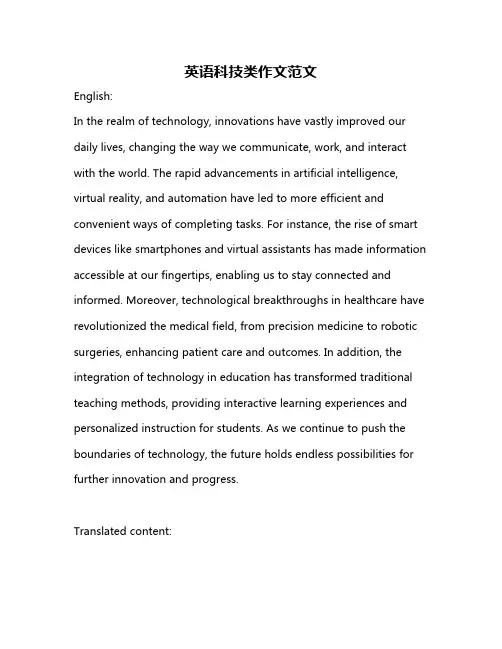
英语科技类作文范文English:In the realm of technology, innovations have vastly improved our daily lives, changing the way we communicate, work, and interact with the world. The rapid advancements in artificial intelligence, virtual reality, and automation have led to more efficient and convenient ways of completing tasks. For instance, the rise of smart devices like smartphones and virtual assistants has made information accessible at our fingertips, enabling us to stay connected and informed. Moreover, technological breakthroughs in healthcare have revolutionized the medical field, from precision medicine to robotic surgeries, enhancing patient care and outcomes. In addition, the integration of technology in education has transformed traditional teaching methods, providing interactive learning experiences and personalized instruction for students. As we continue to push the boundaries of technology, the future holds endless possibilities for further innovation and progress.Translated content:在科技领域,创新大大改善了我们的日常生活,改变了我们与世界沟通、工作和互动的方式。
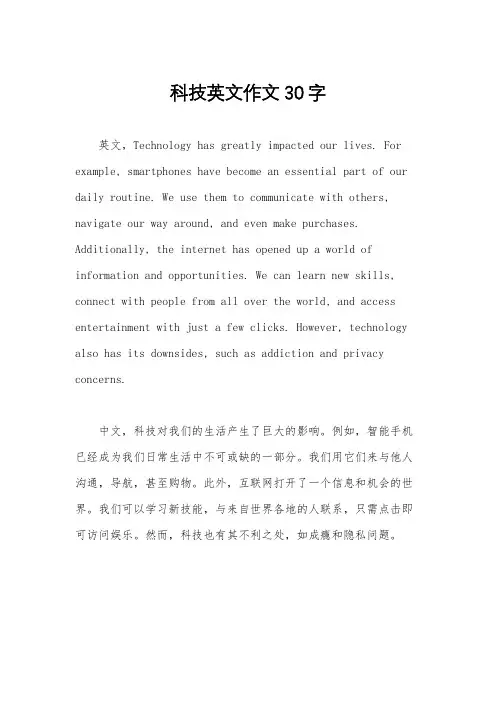
科技英文作文30字
英文,Technology has greatly impacted our lives. For example, smartphones have become an essential part of our daily routine. We use them to communicate with others, navigate our way around, and even make purchases. Additionally, the internet has opened up a world of information and opportunities. We can learn new skills, connect with people from all over the world, and access entertainment with just a few clicks. However, technology also has its downsides, such as addiction and privacy concerns.
中文,科技对我们的生活产生了巨大的影响。
例如,智能手机已经成为我们日常生活中不可或缺的一部分。
我们用它们来与他人沟通,导航,甚至购物。
此外,互联网打开了一个信息和机会的世界。
我们可以学习新技能,与来自世界各地的人联系,只需点击即可访问娱乐。
然而,科技也有其不利之处,如成瘾和隐私问题。
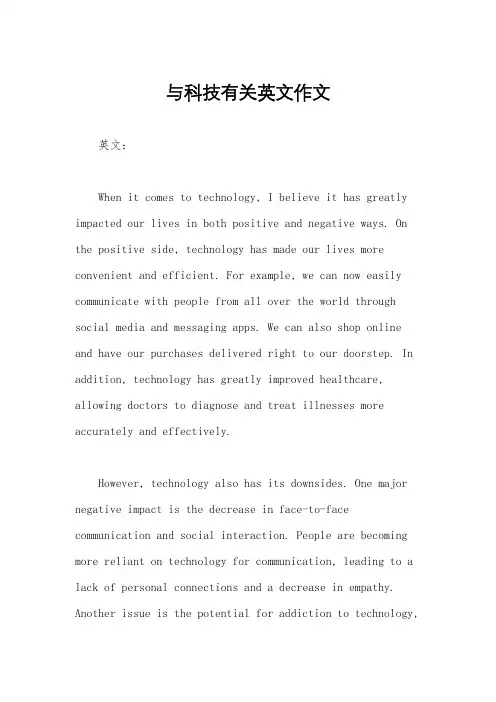
与科技有关英文作文英文:When it comes to technology, I believe it has greatly impacted our lives in both positive and negative ways. On the positive side, technology has made our lives more convenient and efficient. For example, we can now easily communicate with people from all over the world through social media and messaging apps. We can also shop online and have our purchases delivered right to our doorstep. In addition, technology has greatly improved healthcare, allowing doctors to diagnose and treat illnesses more accurately and effectively.However, technology also has its downsides. One major negative impact is the decrease in face-to-face communication and social interaction. People are becoming more reliant on technology for communication, leading to a lack of personal connections and a decrease in empathy. Another issue is the potential for addiction to technology,such as social media or video games, which can lead to negative effects on mental health and productivity.Overall, while technology has greatly improved ourlives in many ways, it is important to be aware of its potential negative impacts and strive for a balance in our use of technology.中文:谈到科技,我认为它在积极和消极方面都对我们的生活产生了巨大影响。
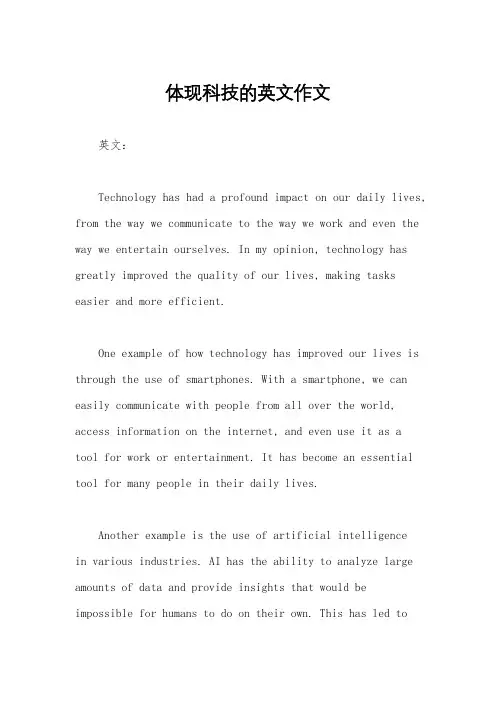
体现科技的英文作文英文:Technology has had a profound impact on our daily lives, from the way we communicate to the way we work and even the way we entertain ourselves. In my opinion, technology has greatly improved the quality of our lives, making tasks easier and more efficient.One example of how technology has improved our lives is through the use of smartphones. With a smartphone, we can easily communicate with people from all over the world, access information on the internet, and even use it as atool for work or entertainment. It has become an essential tool for many people in their daily lives.Another example is the use of artificial intelligencein various industries. AI has the ability to analyze large amounts of data and provide insights that would be impossible for humans to do on their own. This has led toadvancements in fields such as healthcare, finance, and transportation, improving efficiency and accuracy.However, there are also concerns about the negative effects of technology, such as addiction to social media and the potential loss of jobs due to automation. It is important to find a balance between the benefits and drawbacks of technology and use it responsibly.Overall, technology has greatly impacted our lives in both positive and negative ways. It is up to us to use it wisely and make the most of its benefits while minimizing its negative effects.中文:科技对我们的日常生活产生了深远的影响,从我们的通讯方式到工作方式,甚至娱乐方式都有所改变。

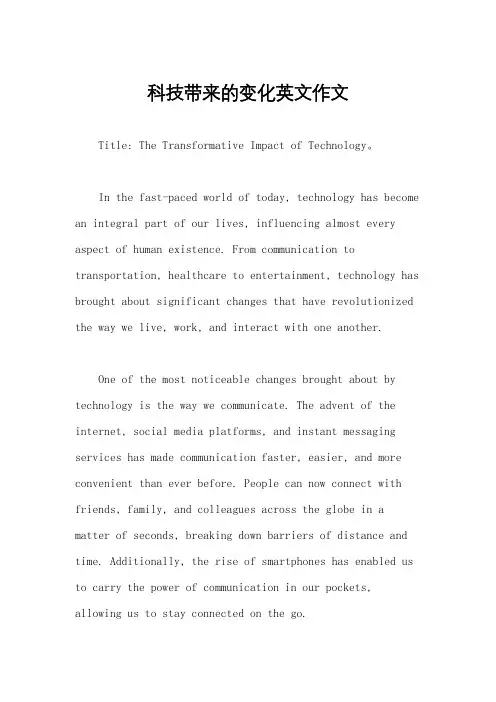
科技带来的变化英文作文Title: The Transformative Impact of Technology。
In the fast-paced world of today, technology has become an integral part of our lives, influencing almost every aspect of human existence. From communication to transportation, healthcare to entertainment, technology has brought about significant changes that have revolutionized the way we live, work, and interact with one another.One of the most noticeable changes brought about by technology is the way we communicate. The advent of the internet, social media platforms, and instant messaging services has made communication faster, easier, and more convenient than ever before. People can now connect with friends, family, and colleagues across the globe in a matter of seconds, breaking down barriers of distance and time. Additionally, the rise of smartphones has enabled us to carry the power of communication in our pockets, allowing us to stay connected on the go.Furthermore, technology has revolutionized the way we work and conduct business. The proliferation of computers, software applications, and automation tools has streamlined processes, increased efficiency, and opened up new avenues for collaboration. Remote work has become increasingly common, allowing employees to work from anywhere with an internet connection. This shift has not only improved work-life balance but also reduced the need for physical office spaces, leading to cost savings for businesses.In the field of healthcare, technology has played a crucial role in improving patient care and outcomes. Advanced medical devices, such as MRI machines, robotic surgery systems, and wearable health trackers, have enabled healthcare professionals to diagnose diseases more accurately and treat patients more effectively. Telemedicine services have also emerged, allowing patients to consult with doctors remotely, particularly useful in areas with limited access to healthcare facilities.Moreover, technology has transformed the way we accessand consume information and entertainment. The rise of streaming services, online gaming platforms, and digital publishing has made content more accessible than ever before. With just a few clicks, we can watch movies, listen to music, play games, and read books from the comfort of our own homes. This has democratized entertainment, allowing people from all walks of life to enjoy high-quality content at affordable prices.In addition to its societal impacts, technology has also brought about significant changes in the global economy. The rise of e-commerce platforms, such as Amazon and Alibaba, has transformed the way we shop, leading to the decline of traditional brick-and-mortar stores and the rise of online retail giants. This shift has not only changed consumer behavior but also disrupted entire industries, forcing companies to adapt or risk becoming obsolete.However, along with its many benefits, technology has also raised concerns about privacy, security, and the ethical implications of its use. The collection andanalysis of vast amounts of personal data raise questions about individual privacy rights and the potential for misuse by corporations and governments. Furthermore, the increasing reliance on automation and artificial intelligence has led to fears of job displacement and economic inequality.In conclusion, technology has undoubtedly brought about profound changes in our society, economy, and way of life. From communication to healthcare, education to entertainment, technology has reshaped almost every aspect of human existence. While the benefits are undeniable, itis essential to address the challenges and ethical considerations that come with the rapid advancement of technology to ensure a more equitable and sustainablefuture for all.。
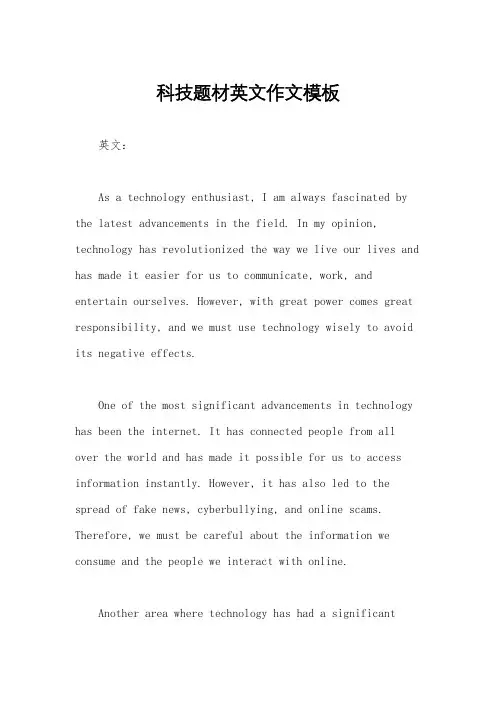
科技题材英文作文模板英文:As a technology enthusiast, I am always fascinated by the latest advancements in the field. In my opinion, technology has revolutionized the way we live our lives and has made it easier for us to communicate, work, and entertain ourselves. However, with great power comes great responsibility, and we must use technology wisely to avoid its negative effects.One of the most significant advancements in technology has been the internet. It has connected people from all over the world and has made it possible for us to access information instantly. However, it has also led to the spread of fake news, cyberbullying, and online scams. Therefore, we must be careful about the information we consume and the people we interact with online.Another area where technology has had a significantimpact is healthcare. With the help of technology, doctors can now diagnose and treat diseases more accurately and efficiently. For example, artificial intelligence can analyze medical images and detect abnormalities that might be missed by human doctors. However, we must also be awareof the ethical implications of using technology in healthcare and ensure that it does not lead todiscrimination or privacy violations.In conclusion, technology has brought about manypositive changes in our lives, but we must also be aware of its negative effects and use it responsibly. As the saying goes, "with great power comes great responsibility."中文:作为一名科技爱好者,我总是被这个领域最新的进展所吸引。
中考作文科技英文范文英文:Technology has greatly impacted our lives in many ways. On one hand, it has made our lives more convenient and efficient. For example, we can now easily communicate with people from all over the world through social media and video conferencing. We can also shop online and have items delivered to our doorstep without ever leaving our homes. Furthermore, technology has revolutionized the way we learn and work. We can access vast amounts of information and resources through the internet and use various software and tools to increase our productivity.On the other hand, technology has also brought about some negative effects. One of the biggest concerns is the impact on our mental and physical health. We spend too much time staring at screens, which can lead to eye strain and poor posture. Moreover, social media and online gaming addiction have become serious problems that can lead todepression and anxiety. In addition, technology has also contributed to the loss of jobs in certain industries as machines and automation take over.Overall, technology has both advantages and disadvantages. It is up to us to use it wisely and in moderation to avoid the negative effects.中文:科技在许多方面对我们的生活产生了重大影响。
英语科技论文写作作文1. Technology is changing the way we live, work, and communicate. From smartphones to social media, we are constantly connected to the digital world.2. The development of artificial intelligence is revolutionizing industries such as healthcare, finance, and transportation. Machines are now able to perform tasks that were once only possible for humans.3. The Internet of Things has transformed our homesinto smart homes, where we can control our appliances and security systems with just a few taps on our smartphones.4. Virtual reality and augmented reality are opening up new possibilities in entertainment, education, and training. We can now immerse ourselves in virtual worlds and interact with digital objects in real time.5. Cybersecurity is a growing concern as more of ourpersonal information is stored online. It is essential to protect our data from hackers and cyber attacks.6. The rise of e-commerce has changed the way we shop, with more people choosing to buy products online rather than in physical stores. This has led to the decline of traditional brick-and-mortar retailers.7. Biotechnology is advancing rapidly, with breakthroughs in gene editing and personalized medicine. Scientists are now able to modify DNA to treat genetic diseases and create targeted therapies for patients.8. Quantum computing is on the horizon, promising to solve complex problems at speeds that are unimaginable with traditional computers. This technology has the potential to revolutionize fields such as cryptography, drug discovery, and climate modeling.。
科技英文作文万能英文:Technology has revolutionized the way we live, work,and communicate. It has made our lives more convenient, efficient, and productive. From smartphones to social media, technology has become an integral part of our daily routine. It has transformed the way we interact with each other and the world around us.One of the most significant impacts of technology is on communication. With the rise of social media and messaging apps, we can now connect with people from all over theworld instantly. We can share our thoughts, ideas, and experiences with others in real-time. This has made communication faster, easier, and more accessible than ever before.Another area where technology has made a significant impact is in the workplace. With the advent of automationand artificial intelligence, many tasks that were once done by humans can now be done by machines. This has led to increased efficiency, lower costs, and higher productivity in many industries.However, technology also has its downsides. It can be addictive, distracting, and even harmful if not used responsibly. For example, spending too much time on social media can lead to social isolation and a lack of real-life connections. Similarly, relying too heavily on technologyin the workplace can lead to job loss and a loss of human skills.In conclusion, technology has had a profound impact on our lives. It has transformed the way we communicate, work, and live. While it has brought many benefits, it is important to use technology responsibly and be aware of its potential drawbacks.中文:科技已经彻底改变了我们的生活、工作和交流方式。
科学技术作文英文英文:Science and technology have played an increasingly important role in our daily lives. From the invention of the wheel to the development of the internet, science and technology have changed the way we live, work, and communicate.One example of how science and technology have changed our lives is the smartphone. With a smartphone, we can easily communicate with people from all over the world, access information, and even control our home appliances.It has become an indispensable part of our daily lives.Another example is the development of renewable energy. As we face the challenge of climate change, renewable energy has become increasingly important. Solar panels, wind turbines, and hydroelectric power plants are just a few examples of how science and technology are helping usto reduce our reliance on fossil fuels and transition to a more sustainable future.In addition to improving our daily lives, science and technology have also contributed to the advancement of medicine. With the development of new drugs and medical technologies, we are able to treat and prevent diseases that were once considered incurable. For example, the development of vaccines has helped to eradicate diseases such as smallpox and polio.Overall, science and technology have had a profound impact on our lives and will continue to shape our future. As we face new challenges, we will rely on science and technology to help us find solutions and create a better world.中文:科学技术在我们的日常生活中扮演着越来越重要的角色。
English technology thesis writingName:Studies: Steel metallurgyGlass:题目:The experiment study of use Iron Tailings and Magnesite Tailings Prepare Cordierite-based Glass CeramicsAbstract:This is work make some exploration about how to use iron tailings and magnesite tailings making glass-ceramics feasibility and preparation methods. Thus, turning waste into wealth and raising added-value of iron ore tailings and magnesite talings . In this work, the main raw material are iron ore tailings and magnesite tailings of Anshan area . And, adding nucleation agent and some other oxide follow the certain proportion , then production MgO - Al2O3- SiO2as the mainly crystalling phase of microcrystalline glass. In the experimental, we use DSC to measured nuclear and crystallizing temperature of glass-ceramics and using X-ray diffraction (XRD), scanning electron microscopy (SEM) and so on to test the glass-ceramics phase, crystallized behavior, and the effect of nucleation agent. Through the experiment, we obtained the best proportion of raw materials and tailings dosage as high as 80% , we also determine the most appropriate treatment of the corresponding system. Keywords:Iron tailings;magnesite tailings ;glass-ceramics;crystallization科技论文的组成及其各项的作用1、Title题名又叫题目、文题、标题,是科技论文的中心和总纲。
Research Reports for Business and Technical WritingWayne LosanoA surprising amount of one's time as a student and professional is spent reporting the results of one's research projects for presentation to teachers, managers, and clients. Indeed, without basic research skills and the ability to present research results clearly and completely, an individual will encounter many obstacles in school and on the job. The need for some research-writing ability is felt nearly equally by college students in all fields, engineering and science as well as business and the humanities. Graduate study often makes great demands on the student's re-search-writing skills, and most professions continue the demand; educa-tion, advertising and marketing, economics and accounting, science and engineering, psychology, anthropology, the arts, and agriculture may all require regular reporting of research data.ELEMENTS OF THE RESEARCH PAPERThe standard research report, regardless of the field or the intended reader, contains four major sections. These sections may be broken down into a variety of subsections, and they may be arranged in a variety of ways, but they regularly make up the core of the report.Problem Section.The first required section of a research report is the statement of the problem with which the research project is concerned.This section requires a precise statement of the underlying question which the researcher has set out to answer. In this same section there should be an explanation of the significance - social, economic, medical, psychological, educational, etc. - of the question; in other words, why the investigation was worth conducting. Thus, if we set out, for example, to answer the question "What is the effect of regular consumption of fast foods on the health of the American teenager?" we must explain that the question is thought to have significant relevance to the health of this seg-ment of the 'population and might lead to some sort of regulations on such foods.A frequent subsection of this problem section is a review of past re-search on the topic being investigated. This would consist of summaries of the contributions of previous researchers to the question under consideration with some assessment of the value of these contributions. This subsection has rhetorical usefulness in that it enhances the credibility of the researcher by indicating that the data presented is based on a thorough knowledge of what has been done in the field and, possibly, grows out of some investigative tradition.Procedures Section.The second major section of the researchreport details, with as much data as possible, exactly how the study was carried out. This section includes description of any necessary equipment, how the subjects were selected if subjects were used, what statistical technique was used to evaluate the significance of the findings, how many observations were made and when, etc. An investigation of the relative effectiveness of various swim-strokes would have to detail the number of swimmers tested, the nature of the tests conducted, the experience of the swimmers, the weather conditions at the time of the tests, and any other factors that contributed to the overall experiment. The goal of the procedures section is to allow the reader to duplicate the experiment if such were desired to confirm, or refute, your findings.Results Section. The third, and perhaps most important, section of the research report is the presentation of the results obtained from the in-vestigation. The basic rule in this section is to give all data relevant to the research question initially asked. Although, of course, one's natural ten-dency might be to suppress any findings which do not in some way support one's hypothesis, such dishonesty is antithetical to good research reporting in any field. If the experiments undertaken fail to prove anything, if the data was inadequate or contrary to expectations, the report should be honestly written and as complete as possible, just as it would be if the hypothesis were totally proven by the research.Discussion Section. The final required section of a research reportis a discussion of the results obtained and a statement of any conclusions which may be drawn from those results. Of primary interest in business and technical research reports is the validity of the results as the bases for company decisions: Will our planned construction project meet federal environmental guidelines and be approved for building? Will this new program attract skilled personnel to our company? Will this new oil recovery technique be financially feasible? Thus, the discussion section of the research report must evaluate the research results fully: were they validly obtained, are they complete or limited, are they applicable over a wide range of circumstances? The discussion section should also point out what questions remain unanswered and perhaps suggest directions for further research.STYLE OF RESEARCH REPORTSResearch reports are considered formal professional communication. As such, there is little emphasis on a lively style, although, of course, there is no objection to writing that is pleasing and interesting. The primary goals of professional communication are accuracy, clarity, and completeness. The rough draft of any research report should be edited to ensure that all data is correctly presented, that all equipment is listed, that all results are properly detailed. As an aid to the reader, headings indicating at least the major sections of the report should be used, and all data should bepresented under the proper headings. In addition to their function of suggesting to the reader the contents of each section, headings enhance the formal appearance and professional quality of the report, increase to some degree the writer's credibility by reflecting a logical and methodical approach to the reporting process, and eliminate the need for wordy tran-sitional devices between sections.Research data should be presented in a way that places proper emphasis on major aspects of the project. For different readers different aspects will take on different degrees of importance, and some consideration should be given to structuring research reports differently for different audiences. Management, for example, will be most concerned with the results of a research project, and thus the results section should be emphasized, probably by presenting it immediately after the problem section and before the procedures section. Other researchers would be most interested in the procedures section, and this should be highlighted in writing up research projects for publication in professional journals or for presentation at professional conferences. For non-technical readers and federal agencies, the implications of the results might be the most important consideration, and emphasis should be placed on the discussion of the report for this readership.For additional clarity and emphasis, major results should be present-ed in a visual format - tables, charts, graphs, diagrams - as well as in averbal one.Beyond checking the report for clarity and accuracy in the presenta-tion of technical data, the author of a research report should review for basic grammatical and mechanical accuracy. Short sentences are prefer-able to long in the presentation of complex information. Listings should be used to break up long passages of prose and to emphasize information.The research writer should try to use the simplest possible language without sacrificing the professional quality of the report. Although specialized terms can be used, pretentious jargon should be avoided. A finished re115 search report should be a readable and useful document prepared with the reader in mind.CONCLUSIONAlthough we struggle with research reports in high school, dread them in college, and are often burdened by them in our professional lives, learn-ing to live comfortably with them is a relatively easy task. A positive atti-tude (i. e., one that sees the oral or written presentation of research results as of equal importance to the data-gathering process); an orderly ap-proach which includes prewriting (i. e., before any actual research is done, the researcher should try to get down on paper as much about the subject under investigation as possible) and a formal research report structure as the framework for the investigation; and a reasonable approach to theactual writing process including editing for accuracy and clarity, will help one to produce effective research reports efficiently.。